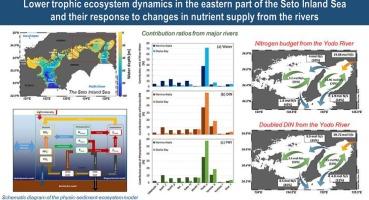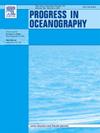Lower trophic ecosystem dynamics in the eastern part of the Seto Inland Sea and their response to changes in nutrient supply from the rivers
IF 3.6
3区 地球科学
Q1 OCEANOGRAPHY
引用次数: 0
Abstract
The eastern part of the Seto Inland Sea is significantly influenced by anthropogenic and territorial nutrient sources, exacerbated by high population and industrial activities. Several rivers, with the Yodo River in Osaka Bay as the largest contributor, play a vital role by providing freshwater, substantial nutrients, and pollution loads to this coastal region. We aimed to understand the responses of ecosystem and coastal dynamics to the changes in nutrient supply from the rivers. Accordingly, a comprehensive three-dimensional physical model coupled with a complicated biogeochemical model was developed to replicate processes in this area. The findings reveal significant differences in nutrient dynamics, and phytoplankton community structures and biomass between Osaka Bay and Harima-Nada. Osaka bay exhibits higher nutrient concentrations, leading to elevated phytoplankton biomass, primarily dominated by a large micro-phytoplankton. Contrastingly, Harima-Nada exhibits lower concentrations, resulting in diminished phytoplankton biomass, with nano-phytoplankton prevailing. The experiment with heightened nutrient inputs from rivers significantly elevated nutrient concentrations for the entire areas in both Osaka Bay and Harima-Nada. Contrastingly, phytoplankton biomass remarkably increased only in the nearshore areas. Furthermore, the response of phytoplankton community structures differs between the two regions. Specifically, in Harima-Nada, nano-phytoplankton shifted primarily to large micro-phytoplankton, while large micro-phytoplankton remains predominant in Osaka Bay. This emphasizes the vital role of nutrient availability in influencing the structure of phytoplankton communities in these regions. The interplay between nutrient availability and phytoplankton dynamics stands as a key factor in comprehending and effectively managing these coastal ecosystems.

濑户内海东部低营养生态系统动态及其对河流养分供应变化的响应
濑户内海东部受人为和领土营养来源的影响很大,人口密集和工业活动加剧了这一影响。以大阪湾的Yodo河为最大贡献者的几条河流发挥着至关重要的作用,为沿海地区提供淡水、大量营养物质和污染负荷。我们旨在了解生态系统和海岸动态对河流养分供应变化的响应。因此,建立了一个综合的三维物理模型,结合复杂的生物地球化学模型来复制该地区的过程。结果表明,大阪湾和Harima-Nada在营养动态、浮游植物群落结构和生物量方面存在显著差异。大阪湾呈现出较高的营养物质浓度,导致浮游植物生物量增加,主要由大型微型浮游植物主导。相比之下,Harima-Nada的浓度较低,导致浮游植物生物量减少,以纳米浮游植物为主。增加河流养分输入的试验显著提高了大阪湾和Harima-Nada整个地区的养分浓度。相比之下,浮游植物生物量仅在近岸地区显著增加。此外,两个地区浮游植物群落结构的响应也存在差异。具体而言,在Harima-Nada,纳米浮游植物主要转向大型微型浮游植物,而在大阪湾,大型微型浮游植物仍然占主导地位。这强调了养分有效性在影响这些地区浮游植物群落结构方面的重要作用。养分有效性与浮游植物动态之间的相互作用是理解和有效管理这些沿海生态系统的关键因素。
本文章由计算机程序翻译,如有差异,请以英文原文为准。
求助全文
约1分钟内获得全文
求助全文
来源期刊

Progress in Oceanography
地学-海洋学
CiteScore
7.20
自引率
4.90%
发文量
138
审稿时长
3 months
期刊介绍:
Progress in Oceanography publishes the longer, more comprehensive papers that most oceanographers feel are necessary, on occasion, to do justice to their work. Contributions are generally either a review of an aspect of oceanography or a treatise on an expanding oceanographic subject. The articles cover the entire spectrum of disciplines within the science of oceanography. Occasionally volumes are devoted to collections of papers and conference proceedings of exceptional interest. Essential reading for all oceanographers.
 求助内容:
求助内容: 应助结果提醒方式:
应助结果提醒方式:


